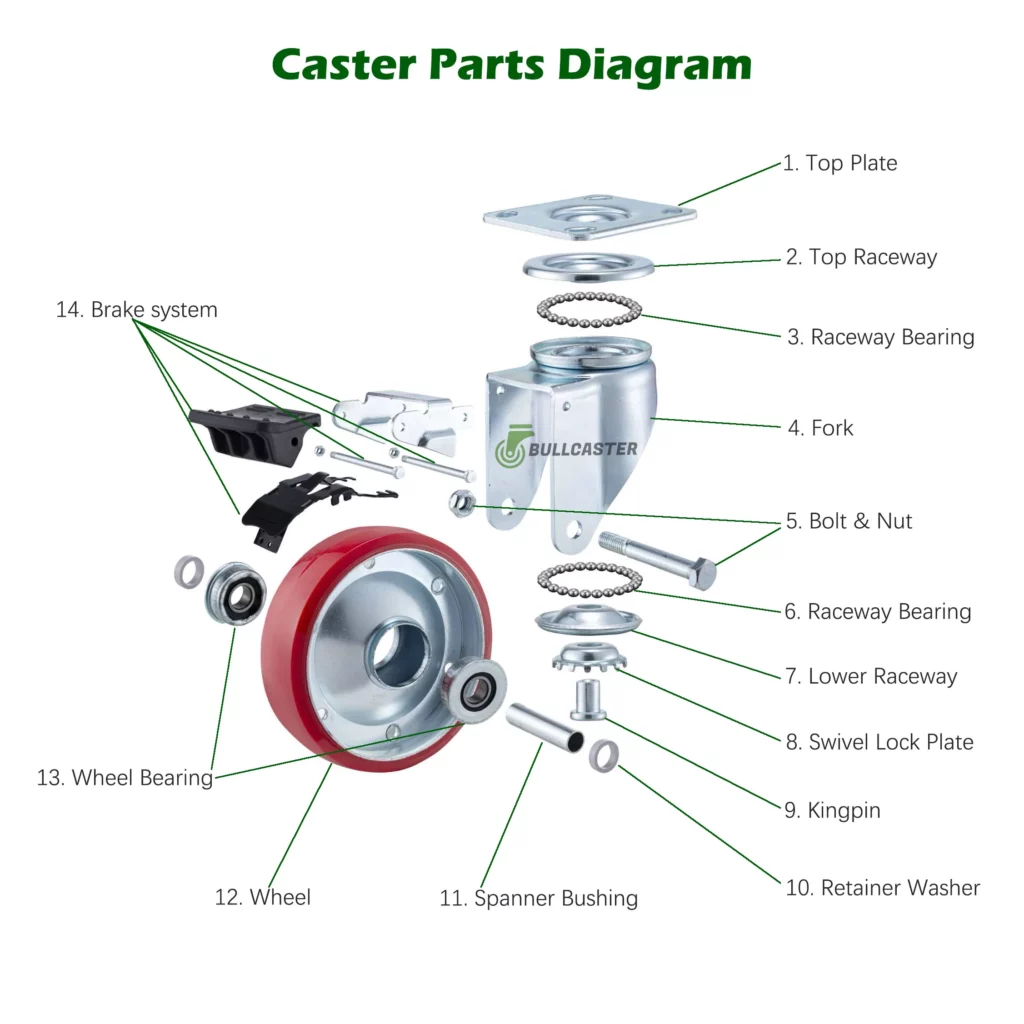Do you know what parts are casters made of?
Do you know the function of each part of the caster?
This article will introduce you to caster wheel assembly in detail.
Please look at the picture below. We use a Japanese heavy-duty industrial caster as an explanation. The industrial casters currently on the market are the same in structure and can be regarded as a common industrial caster assembly.

Caster Wheel Parts Introduction
A. Caster Wheel Top Plate(1)
The top plate is the mounting plate of the caster and is part of the caster bracket. There are usually 4 or 6 prepared holes on the top plate to facilitate the installation of the caster.
In addition to the caster wheel top plate, casters also have various mounting methods such as stem, bolt hole, expand stem, rigid, etc. You can read our previous article to learn about caster mounting types.
It is worth noting that the thickness of the top plate is one of the determining factors of the caster’s load-bearing capacity. Usually, we will thicken the thickness of the caster bracket and top plate according to the user’s needs to greatly increase the caster’s load capacity.
B. Caster Raceway and Raceway Bearing(2.3.6.7)
A caster wheel raceway is a component of a swivel caster. The raceway in a caster wheel is essentially the interface between the stationary and rotating parts of the caster. It consists of two main parts:
- Inner Raceway: This part is attached to the stem or the mounting plate of the caster, and it remains stationary.
- Outer Raceway: This part is attached to the wheel assembly and is the part that rotates or swivels.
Between these two raceways, there are usually bearings, which can be ball bearings or roller bearings. These bearings facilitate smooth rotation or swiveling of the wheel assembly relative to the stationary part of the caster. The raceway allows the caster to rotate 360 degrees, enabling the wheel to change direction smoothly and with minimal effort.
Here’s how it works:
- Swivel Head: This is the top part of the caster where the raceway is located. The swivel head allows the caster to rotate around its vertical axis.
- Top Raceway: The raceway itself is a set of circular tracks where ball bearings sit. These bearings allow the swivel head to turn smoothly with minimal friction. The top raceway is often a double-ball raceway for added strength and smoother rotation.
- Ball Bearings: Positioned within the raceway, these small metal balls reduce friction between the moving parts of the caster, facilitating smooth motion.
The design and construction of the raceway are crucial for the performance and durability of the caster. A well-designed raceway will reduce friction, allowing for easier movement and better load-bearing capacity. This is particularly important in industrial or heavy-duty applications where casters may need to support and move substantial weights.
C. Caster Wheel Bracket Fork (4)
The caster wheel bracket fork is the structure that connects the wheel bolts, top plate, and caster brake system.
Its material is usually steel plate, and its surface treatment is usually galvanized, electrophoretic painting, chrome plating, etc. For some high-end needs, the material can be нержавеющая сталь bars.
It is worth noting that the material and thickness of the bracket fork are also of important factors affecting the load-bearing capacity of the caster.
D. Bolt and Nut (5)
The main function of Bolt and Nut is to install the wheel onto the caster bracket so that the wheel and bracket form a usable caster. Heavy-duty casters require the use of thicker and higher-strength bolts.
E. Swivel Lock Plate (8)
A caster wheel swivel lock plate is a component used in certain types of casters to provide the ability to lock the swivel action of the caster. This feature is particularly useful in applications where it is necessary to convert a swivel caster into a rigid one, either temporarily or permanently.
The swivel lock plate allows the user to lock the caster’s swiveling mechanism. When engaged, the lock prevents the caster from rotating around its vertical axis, thus transforming the swivel caster into a rigid, non-swiveling caster. This can be useful in situations where stability is required, or when the caster needs to travel in a straight line without deviation.
F. Kingpin (9)
The function of the Kingpin is to combine the caster’s top plate, raceway, fork, swivel lock, and other components to form a complete caster bracket.
G. Caster Wheel Bearing (10.11.13)
Caster wheel bearings are crucial for reducing friction, enabling smooth and easy wheel rotation. They enhance mobility, especially under heavy loads, and contribute to the caster’s overall load-bearing capacity. There are many types of caster bearings. You can check out my previous article about the introduction of caster bearings.
H. Caster‘s Wheel(10.11.13)
The wheel is installed on the caster bracket through bearings, spanner bushing, retainer washer, bolt, and nut.
There are many types of wheels, many materials, and many sizes. It is often necessary to choose different types of wheels according to different needs. You can check our guide on caster materials to choose the wheels that best suit your needs.
I. Caster Wheel Brake Assembly(10.11.13)
caster wheel brake is a mechanism added to a caster to allow it to be locked in place, preventing the wheel from rolling. This feature is essential for ensuring stability and safety, especially in applications where the caster supports heavy loads or is on an incline. The brake can be engaged manually, often with a foot pedal, and when activated, it applies pressure to the wheel or its housing to stop movement. There are different types of caster brakes, including total lock brakes that also lock the swivel action, providing complete immobility of the caster.
If you need to purchase casters, please связаться с Булкастер directly, we can provide you with comprehensive casters solutions.


